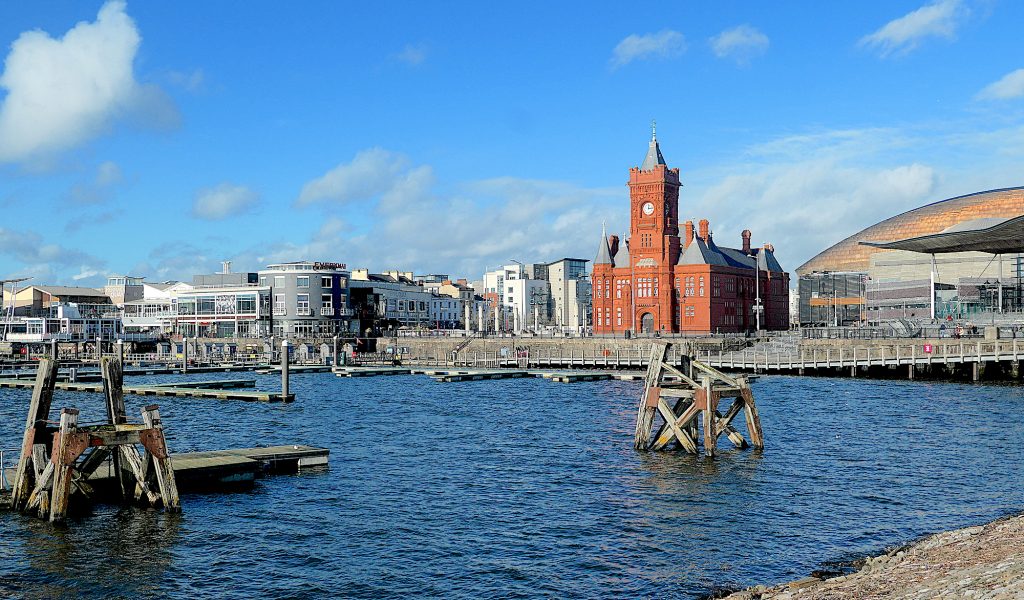Cardiff Bay
In the 18th century, canals were the easiest way of transporting goods, unlike the extensive road and rail networks today. When the Glamorganshire Canal was completed in 1794, Cardiff was linked with Merthyr, and coal was brought down from the valleys on barges.
The area now known as Cardiff Bay first came into being through the construction of a number of docks for transporting coal in the 1830’s. By the 1880’s Cardiff had become the largest town in Wales, mainly due to the money brought in by the coal industry, promoting vast growth, a busy industrial centre and diverse community around the areas closet to the docks, then known as Tiger Bay. Tiger Bay was an active commercial hub, where the influx of sailors leads to a multi-cultural community with over 50 nationalities. Goods were shipped in and out, including coal which formed the lifeblood of the Cardiff economy. Work also took place in the 7 active dry docks repairing ships, such as the Bute Dry dock and Channel Dry Dock. The name ‘Tiger Bay’ was used by sailors, as a slang term for docklands that were rough and infamous areas. Yet, the Bay was home for many people including newcomers who married Welsh inhabitants, creating a melting-pot of foreign and Welsh culture.

Many families from Cardiff and its surrounding areas have long-standing connections to the industrial development of the area, with generation after generation of coal workers, and fathers and grandfathers sharing the same trade. This influence stretched across the globe and Cardiff lead the industrial revolution – the first £1 million pound deal was even signed within the Coal Exchange Building in the Butetown area of the city! Having fallen upon hard times until relatively recently, this historic building was rescued, restored and now serves as a Grade-II listed, high-end hotel.
At the start of the 1990s, the hustle and bustle of its 19th and early 20th century heyday had ceased and the docks and bay lay as an unused relic. However, new life was soon breathed into the area. The construction of the tidal barrage in 2001 created a freshwater lake, using the outflow from the Taff and Ely rivers. This feat of engineering includes 5 sluice gates to control the water level, and 3 locks to allow boats to sail in the bay. At the time, it was the largest engineering project in Europe. A stroll in the bay or the barrage is a great way to spend time relaxing and spotting ships drifting on the water.
Today, Cardiff Bay is home to Mermaid Quay, and area which includes a range of vibrant restaurants, bars, the Senedd (Welsh Parliament) and Grade I listed Pier Head Building. The Norwegian Church was constructed in 1868 for Norwegian Seafarers during the industrial revolution, and it now houses a coffee shop and exhibition space, supporting local artists and activities. One of the most famous authors of children’s books, Roald Dahl, was born in Cardiff to Norwegian parents. Baptised in the Norwegian church, Dahl went on to an illustrious career as an author: writing 39 books which were illustrated by Quentin Blake. Many generations of children have had their imaginations captured by these books, and his legacy has continued since his death in 1990. At Cardiff Bay, you can also find the Roald Dahl Plass, which is an open public space hosting the Wales Millennium Center. Within the centre and outside on the Plass, enjoy performances, arts and open-air concerts. During summer, the Plass also holds markets and festivals including the Cardiff Food Festival and Eisteddfod of Wales (also known as the Eisteddfod ‘with no fences’ because there was no fee for entry).
For those with an interest in all things science and technology, Techniquest offers a fun and educational family day out. There are many science attractions to interact with and frequent science theatre shows to watch and enjoy. Alternatively, for a more relaxing experience, take the water taxi for a cruise around Cardiff Bay, or up to the grounds of Cardiff Castle and the Bute Park giving you easy access to the city centre.
Connect to the natural word with the Cardiff Bay Wetland Reserve. A haven for nature in the city, the wetlands are easily accessible with a gravel walkway and boardwalk. Kids can enjoy nature trails and there are stunning views out into the water. Further along, a walk along the Barrage reveals impressive locks, a fish pass and a play area. You may even be able to spot Roald Dahl’s Enormous Crocodile around somewhere!
 Severn Estuary Partnership
Severn Estuary Partnership